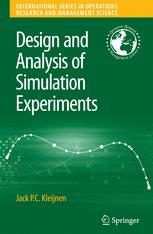

Most ebook files are in PDF format, so you can easily read them using various software such as Foxit Reader or directly on the Google Chrome browser.
Some ebook files are released by publishers in other formats such as .awz, .mobi, .epub, .fb2, etc. You may need to install specific software to read these formats on mobile/PC, such as Calibre.
Please read the tutorial at this link: https://ebookbell.com/faq
We offer FREE conversion to the popular formats you request; however, this may take some time. Therefore, right after payment, please email us, and we will try to provide the service as quickly as possible.
For some exceptional file formats or broken links (if any), please refrain from opening any disputes. Instead, email us first, and we will try to assist within a maximum of 6 hours.
EbookBell Team

4.4
42 reviewsThis is an advanced expository book on statistical methods for the Design and Analysis of Simulation Experiments (DASE). Though the book focuses on DASE for discrete-event simulation (such as queuing and inventory simulations), it also discusses DASE for deterministic simulation (such as engineering and physics simulations). The text presents both classic and modern statistical designs. Classic designs (e.g., fractional factorials) assume only a few factors with a few values per factor. The resulting input/output data of the simulation experiment are analyzed through low-order polynomials, which are linear regression (meta)models. Modern designs allow many more factors, possible with many values per factor. These designs include group screening (e.g., Sequential Bifurcation, SB) and space filling designs (e.g., Latin Hypercube Sampling, LHS). The data resulting from these modern designs may be analyzed through low-order polynomials for group screening and various metamodel types (e.g., Kriging) for LHS.
In this way, the book provides relatively simple solutions for the problem of which scenarios to simulate and how to analyze the resulting data.
The book also includes methods for computationally expensive simulations. It discusses only those tactical issues that are closely related to strategic issues; i.e., the text briefly discusses run-length and variance reduction techniques.
The leading textbooks on discrete-event simulation pay little attention to the strategic issues of simulation. The author has been working on strategic issues for approximately forty years, in various scientific disciples--such as operations research, management science, industrial engineering, mathematical statistics, economics, nuclear engineering, computer science, and information systems.
The intended audience is comprised of researchers, graduate students, and mature practitioners in the simulation area. They are assumed to have a basic knowledge of simulation and mathematical statistics; nevertheless, the book summarizes these basics, for the readers' convenience.